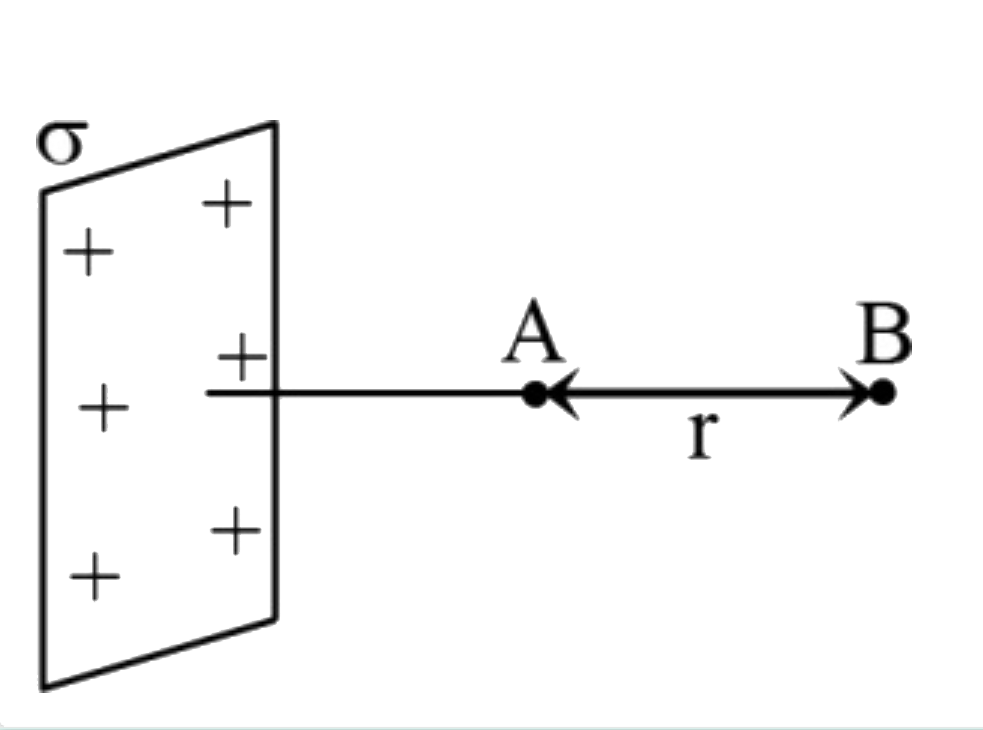An infinite nonconducting sheet of charge has a surface charge density of 107C/m2. The separation between two equipotential surfaces near the whose potential differ by 5V is Solution in Telugu
0.88 cm
0.88 mm
0.88 m
5×10−7m
The correct Answer is:B
Step by step video, text & image solution for An infinite nonconducting sheet of charge has a surface charge density of 10^(7) C//m^(2). The separation between two equipotential surfaces near the whose potential differ by 5V is by Physics experts to help you in doubts & scoring excellent marks in Class 12 exams.
Topper's Solved these Questions
- BOOK - AAKASH SERIESCHAPTER - ELECTROSTATICSEXERCISE - LECTURE SHEET (EXERCISE - IV) (LEVEL - II (ADVANCED) STRAIGHT OBJECTIVE TYPE QUESTIONS)6videos
ELECTROSTATICS
- BOOK - AAKASH SERIESCHAPTER - ELECTROSTATICSEXERCISE - LECTURE SHEET (EXERCISE - IV) (LEVEL - II (ADVANCED) MORE THAN ONE CORRECT ANSWER TYPE QUESTIONS)4videos
ELECTROSTATICS
- BOOK - AAKASH SERIESCHAPTER - ELECTROSTATICSEXERCISE - LECTURE SHEET (EXERCISE - III) (LEVEL - II (ADVANCED) INTEGER TYPE QUESTIONS)2videos
ELECTROSTATICS
- BOOK - AAKASH SERIESCHAPTER - ELECTROMAGNETICSEXERCISE - ADDITIONAL EXERCISE6videos
ELECTROMAGNETICS
- BOOK - AAKASH SERIESCHAPTER - ELEMENTS OF VECTORSEXERCISE - QUESTIONS FOR DESCRIPTIVE ANSWERS9videos
ELEMENTS OF VECTORS
Similar Questions
Two metallic solid spheres of radii R and 2R are changed such that both of them have same charge density σ. If the spheres are located for away from each other and connected by a conducting wire, the new charge density on bigger sphere is :
01:46View SolutionFour charges of 1 mC, 2mC, 3mC and- 6 mC are placed one at each corner of the square of side 1m. The square lies in the x-y plane with its centre at the origin.
03:13View SolutionTwo infinite line charges, each having a uniform density λ. Pass through the midpoints of two pairs of opposite faces of a cube of edge L as shown in figure. The modulus of the total electric flux due to both the line charges through the face is ABCD is λL/(kε0) find the value of k ?
 01:45View Solution
01:45View SolutionWhat is the radius of the path of an electron (mass 9 × 10-31 kg and charge 1.6×x10–19 C) moving at a speed of 3×x107 m/s in a magnetic field of 6x×10−4 T perpendicular to it? What is its frequency? Calculate its energy in keV. (1eV=1.6×10−19J)
02:44View SolutionFind the components of vector ¯¯¯A=2ˆi+3ˆj along the directions of ˆi+ˆjandˆi−ˆj
02:29View SolutionAn infinite sheet of charge has a surfaces charge density of 10^-7C/m^2 . The separation between two equipotential surfce whose potentials differ by 5 V is
02:53View Solution1g of cork with a charge 1μC floats motionless 1cm above a large uniformly charged plane near the surface of the earth. The surface charge density of the plane, assuming it to be an infinite sheet,is
03:04View SolutionAn infinite changed sheet has 10−7Cm−2 surface density of change .How far apart are the equipotential surface differing by 5 voits ?
[Hint: Elwctri intensity =rate of fall of potential .]03:34View Solutionआवेश की अनंत समतल चादर पर पृष्ठ आवेश घनत्व 8.85 माइक्रोकूलॉम /मीटर2 है। चादर के निकट वैधुत क्षेत्र की तीव्रता ज्ञात कीजिए।
01:48View SolutionAn infinite sheet of charge has surface charge density sigma . The separation between two equipotential surfaces, whose potential differ by V is:
07:08View SolutionAn infinite conducting sheet has surface charge density σ. The distance between two points is r. The potential difference (VA−VB) between these point is
 View Solution
View Solutionएक अनन्त विस्तार की आवेश परत का तल आवेश घनत्व 10(−7)Cm−2 है। इसके क्षेत्र में दो समविभव पृष्ठ जिनके बीच 5.0 V का विभवान्तर हो, आपस में कितनी दूरी पर स्थित होंगे?
02:30View Solution10^(8)C//m^(2) An infinite plane sheet with charge density is placed in the air. In this situation, how far are two equipotential planes, each with a potential difference of 5V?
03:01View SolutionAn infinite nonconducting sheet has a surface charge density of σ=0.10μC/m2 on one side. How far apart are equipotential surfaces whose potentials differ by 50 V?
02:17View SolutionAn infinite nonconducting sheet with a uniform surface charge density sets up parallel equipotential surfaces. Any pair of surfaces differing by 25.0 V are separated by 8.80 mm. (a) What is the magnitude of the surface charge density? (b) If an electron is released near the sheet, does it tend to move from higher to lower potential or vice versa ?
03:20View SolutionElectric field at a point near a uniformaly charged infinite plane sheet having surface density of charge sigma is given as E= ________________
06:18View Solution

